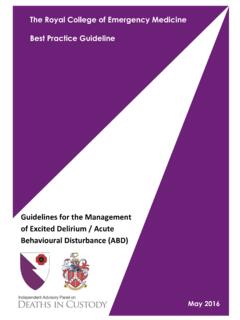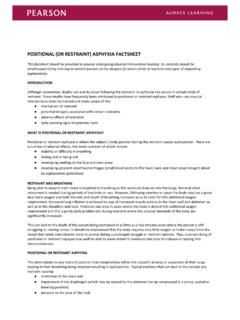Transcription of Report of the Independent Review of Deaths and Serious ...
1 Report of the Independent Review of Deaths and Serious Incidents in Police Custody Rt. Hon. Dame Elish Angiolini DBE QC. January 2017. Contents Acknowledgments 5. Executive Summary 7. Background 7. Key findings 7. Guarding the Vulnerable 14. 1. Introduction 21. Background 21. Terms of Reference 22. Families 23. Previous reports 23. Other Ongoing Reviews and Action 24. The Legal Framework 25. Trends in Deaths in police custody and suicides following police custody 26. Summary 28. 2. Restraint 31. Introduction 31. Mental Health and restraint 33. positional asphyxia 35. Training 36. Length of prone restraint 37. excited delirium /Acute Behavioural Disturbance 38. Struggle and restraint 40.
2 The safety officer approach 41. Alternatives to manual force 42. Transportation in police vehicles 45. Recording of police use of force 46. 3. Intoxication 51. Introduction 51. Observation regimes 51. Drying out' Centres 55. Denial of healthcare to intoxicated detainees 57. Alcohol withdrawal 59. Training on intoxication 59. 4. Mental Health 63. Introduction 63. Modern policing and mental health 67. The inappropriateness of police custody 68. |1. Mental health training 69. Removing mentally ill people from the policing context 70. Arresting for criminal offences rather than section 136 of the Mental Health Act 1983 71. Detention under section 136 in the police station as a place of safety' 72.
3 Liaison and Diversion Schemes 75. Avoiding detention under section 136 Mental Health Act 1983 76. Use of police officers to conduct restraint within mental health detention settings 77. 5. Ethnicity 83. Introduction 83. Race and the investigative process 85. Stereotypical assumptions 87. Statistics on ethnicity 89. Accountability 91. 6. Self-inflicted Deaths 95. Introduction 95. Pre-release Risk Assessment 98. Medical advice at point of release 100. Other agencies 101. 7. Children and Young People 105. Introduction 105. Post-release Deaths 106. Inspection criteria 107. Overnight detention of children 107. Appropriate Adults 110. 8. Other Vulnerable Groups 113. Introduction 113. Social communication and perception disorders 114.
4 Epilepsy 115. Support card schemes 115. Women 116. Homeless people 118. 9. IPCC Investigations 121. Introduction 121. IPCC Review of Article 2 cases 122. NatCen research 122. IPCC one-year-on Report 124. IPCC independence 126. Deaths and Serious Injuries Unit 128. Family liaison and bereavement training 129. Disclosure to families 131. Pre-Interview disclosure 132. 2 | Report of the Independent Review of Deaths and Serious incidents in Police Custody Length of IPCC investigations 133. The immediate aftermath 134. 10. Police Conferral 141. Introduction 141. Separation of officers 143. Police non-conferral guidance 144. Police view on conferral 145. Court of Appeal ruling, 2014: R (Delezuch) v Chief Constable & R (Duggan) v ACPO 146.
5 International comparisons 150. 11. NHS Investigations 153. Introduction 153. NHS England 154. NHS Wales 155. Family liaison 156. 12. Police Custody: Medical Care, Inspections and External Agencies 159. Introduction 159. Quality of medical care in police stations 159. Custody Detention Officers 161. NHS Commissioning of healthcare 162. Joint protocols with external medical services 163. Independent Custody Visitors 164. A change in approach? 166. 13. Police Misconduct 169. Introduction 169. Conduct investigations 170. Witness statements and interviews 170. Resignation and retirement 172. Suspension 172. Misconduct or gross misconduct 173. Family engagement 175. Sanctions 176. 14. Prosecutions 179.
6 Introduction 179. Referrals to CPS 180. CPS decision making 181. Corporate Manslaughter 182. Delays in CPS decision making 184. Expert evidence 185. CPS communication with families 186. Health and Safety Executive and the CPS 187. |3. 15. Family Support 193. Introduction 193. Access to information and advice 195. Information released to the public 195. Attending inquests 197. Counselling and support services 197. The INQUEST Charitable Trust 199. Families as a source of learning 199. 16. The Coronial System 203. Introduction 203. Post-mortem Examinations 206. Disclosure 208. Coroners' investigations 209. Pre-inquest reviews 211. Family experience 212. Inequality of arms 213. Prevention of future Deaths 217.
7 A National Coroner Service 218. 17. Sustained Learning 225. Introduction 225. A coordinated approach 226. Learning from investigations and inquests 227. An Office for Article 2 Compliance 229. 18. Summary of Recommendations 235. Restraint 235. Custody environment 235. Health and wellbeing 237. Funding for families and family support 238. Communications 240. Investigations 241. Coroners and Inquests 243. Accountability 243. Training 244. Learning 245. Statistics 246. Research 247. Annex A: Meetings 249. Annex B: Public Consultation 253. Annex C: INQUEST Report of the Family Listening Days 255. 4 | Report of the Independent Review of Deaths and Serious incidents in Police Custody Acknowledgments This Review looked at the wide range of circumstances around Deaths and Serious incidents in police custody and of suicides occurring shortly after release from police custody.
8 The process involved examination of events from the initial restraint or other circumstances preceding the death, through the investigation and Inquest to the outcome of these formal investigative processes. I am very grateful to the great many individuals and representatives of organisations who met me or provided information or submissions. I am particularly indebted to those who attended the many focus group meetings. The ability to listen to the experiences and advice of the families of those who have died in custody or shortly thereafter was of enormous assistance. My heartfelt thanks go to the many families who attended the INQUEST Listening days or individual meetings with me and who allowed me to hear their personal experiences of the system.
9 Sadly, too many of the Family members have become unwilling experts on the issues and at great emotional and personal cost. A great number of police officers and members of the Police Federation also made very valuable and constructive contributions during the Review . I am also indebted to Giles Lindon and Stephen Roe of the Home Office for their research and Review of the international evidence. Their Report accompanies this Review . Throughout the Review I benefitted greatly from the advice, guidance of, and discussion with, a Reference Group. The members of the Group were Chief Constable Nick Ephgrave of Surrey Police, Raju Bhatt, Solicitor, of Bhatt Murphy Solicitors, and Karon Monaghan QC of Matrix Chambers.
10 They each gave very generously of their time and great expertise. The Home Secretary appointed Deborah Coles, Director of INQUEST, as my expert advisor and her support, sage counsel and expertise throughout the Review has been outstanding. The organization and conduct of the family listening days and provision of detailed and expert submissions by Victoria McNally and Nogah Ofer of INQUEST have also had a major impact on the quality, range and depth of information available to me. I am very thankful to them both. My Executive Assistant at St Hugh's College, Oxford, Amanda Moss BEM was of great assistance in organizing my diary and coordinating papers and meetings. Finally, I owe an enormous debt of gratitude to the Secretary to this Review , Mark Lipczynski, who was seconded to the Review from the Home Office.











